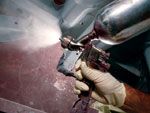
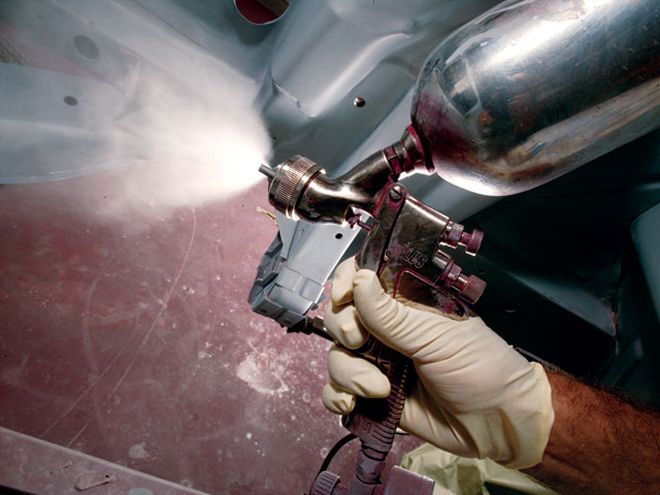
Finally, the moment of truth. All the steps we've covered so far in this series-metal prep and repair, panel alignment, shooting primer, and block-sanding-have led up to this: making your car-color dreams a reality. To help make that dream come true, we're approaching the subject of spraying color from a number of different angles. We spoke with several professional painters looking for insider tips. We collected information on how to choose the right spray gun and how to set up a gun to get the results you want. (I even took a painting class to bolster my neophyte spraying skills and discovered I'm way more Tim Conway than Junior Conway with a spray gun in my hand.)
Yet all the tips and insider scoop we can cram into these few pages won't help you as much as the next three words: Practice, practice, practice. It's one thing to read about spray technique, but it's a whole other deal to actually "shoot a single, flowing coat," as they taught us in class. When you're learning to paint, junk panels, walls covered with masking paper, and other targets that don't much matter are your friends. Perfect your gun handling off the car, and you'll like what you put on the car a whole lot better.
Also, don't be too ambitious with your first paint projects. Specialty products like flakes and candies are a lot tougher to get right than solid colors, and single-stage paint will require fewer passes with the gun than a basecoat/clearcoat combo. If you work your way into the more complicated finishes as you gain experience, you'll be far more satisfied with the process and your results.
How the Pros Do It
We talked to several painters-Tim Beard of Hot Rod Restorations, Dave Lane of FastLane Rod Shop, Brian Lynch from House of Kolor (HoK), John Morrow of Johns Customz & Performance (JCP), and Sears' Dan Swanson-about the steps they take when applying color. Here's what works for them.
The base: Most of our guys like to spray color on a ground coat that consists of a sealer or primer-sealer so the surface is as even as possible. According to Swanson, the primer-sealer also keeps sanding scratches from being pulled up by the later topcoats. All our painters recommended matching the ground coat to the color of the topcoat as closely as possible or you risk getting a variation on the color you want. Taking this a step further, Lynch said HoK sealers can be tinted and then used as a ground color, allowing you to skip the basecoat step. "But not all companies recommend clearcoating over sealer," he advised.
Keep it clean: Surfaces must be immaculate prior to painting or you risk contaminating the paint and ruining the job. Swanson likes to use soapy water, as "solvent-type final cleaners may not fully evaporate before you start painting and can leave some ugly rag marks." The rest of the group uses solvents, cleaners, or degreasers to get any residue off the car. Morrow has a helper wipe right behind him to keep the wax and grease remover from doing just what Swanson feared. Lint-free rags ("Is there really such a thing?" Swanson asked.) and tack rags keep fabric bits from the paint.
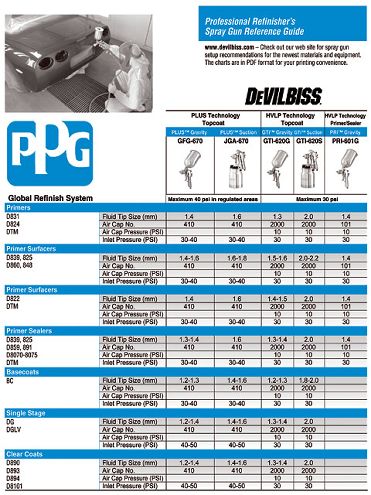 This spray-gun reference guide from DeVilbiss is an example of the information gun manufacturers publish regarding how to set up their guns for a particular brand of paint and its various types, from primers and basecoats to clears.
This spray-gun reference guide from DeVilbiss is an example of the information gun manufacturers publish regarding how to set up their guns for a particular brand of paint and its various types, from primers and basecoats to clears.
Gun choice: Most of our painters, even those not in air-quality-compliant areas, shoot with high volume/low pressure (HVLP) guns. (More on gun types below.) For some, it's a matter of law, but even those who have a choice like the way an HVLP gun reduces the amount of paint that's wasted as overspray.
Gravity-fed guns (with the paint cup on top) are preferred over the old-fashioned siphon type (with the cup under the gun) for several reasons. They're lighter, have a better balance, and the gravity feed means you can shoot until the cup is empty, something the siphon gun won't do. "Where the siphon guns come in handy, though, is when you're spraying an interior or hard-to-reach spot," Morrow noted. "The venturi effect in the cup feeds paint to the gun no matter what angle it's held at, even upside down. A gravity-feed gun won't do that."
Gun setup: Few of the pros could tell us specifics about how they set up their guns-fluid-tip sizes, air pressure going into the gun, things like that. They've been doing it for so long, they've developed a feel for the right settings to deliver the desired spray pattern. Or they stick so closely to one type of paint, they can set their guns once and leave them.
Some take Beard's approach, which is to have an assortment of guns, each set up for a different kind of paint. "I'm fortunate enough to have five, six guns with different tip sizes, and I can grab the one I like for a certain type of paint. I use a 1.3 [tip] for metallics and pearls, 1.3 or 1.5 for solids, 1.5 also for clear, and a 2.0 nozzle for primer. Different colors have different thicknesses; blacks are thicker because they have more solids." Beard paused. "It's easier for me to mix the paint, pick up the gun, and go. If I think about it too much, I screw it up."
When Beard does have to make adjustments, he minimizes his variables-he locks down his material flow and air pressure to predetermined settings and then alters his distance, speed, or pattern size.
How To Set Up A Spray Gun
Gun Control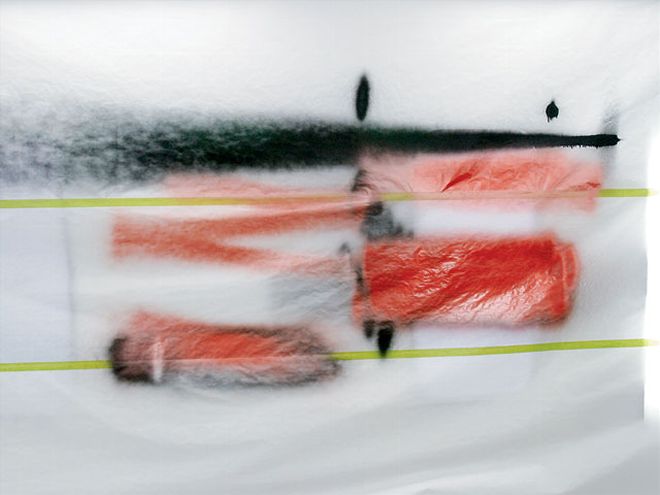 <STRONG>Gun Control</STRONG><BR>On masking paper taped to the wall of the spray booth, Lynch demonstrated several gun-control concepts. The black stripe at the top of the wall was shot from left to right, changing nothing but the distance between the gun and the wall. At the far left, there's not enough paint on the wall, and the pattern is spotty and coarse; at the far right, the pattern gets really small and dense, with so much paint in such a small area that it's dripping. See the black oval above the stripe at about its midpoint? That's where this gun was at its sweet spot-about 7 inches from the paper. The oval is the pattern Lynch wants, with lots of fine, small droplets that maximize coverage. The orange/bronze rectangle below the black stripe is where Lynch demonstrated gun passes with a 70 percent overlap-ideal, he said, to keep the "meat" of the pattern where it covers best. That Z-shaped stripe? That's where Lynch described my Zorro spraying technique. Don't do that.
<STRONG>Gun Control</STRONG><BR>On masking paper taped to the wall of the spray booth, Lynch demonstrated several gun-control concepts. The black stripe at the top of the wall was shot from left to right, changing nothing but the distance between the gun and the wall. At the far left, there's not enough paint on the wall, and the pattern is spotty and coarse; at the far right, the pattern gets really small and dense, with so much paint in such a small area that it's dripping. See the black oval above the stripe at about its midpoint? That's where this gun was at its sweet spot-about 7 inches from the paper. The oval is the pattern Lynch wants, with lots of fine, small droplets that maximize coverage. The orange/bronze rectangle below the black stripe is where Lynch demonstrated gun passes with a 70 percent overlap-ideal, he said, to keep the "meat" of the pattern where it covers best. That Z-shaped stripe? That's where Lynch described my Zorro spraying technique. Don't do that.
The mix: Follow the manufacturer's recommendations regarding the use of catalysts or hardeners, Lynch said. "You don't want to mess with that ratio. Now, a reducer you can mess with, to vary the viscosity of the paint based on the conditions." Hot weather can thin the paint and speed up flow, so you'll want to use a different reducer or less reducer than on a cooler day.
Beard takes a different approach: "I use a midtemp reducer all the time, even when it's 100 degrees. That way if I have to do a spot repair in December, it won't change the color. I may have to work a little faster when it's hot, but different reducers have changed my colors."
Whole versus apart: Our guys were pretty evenly split between those who prefer to paint a car in pieces and those who paint the car assembled. Those who paint the car whole have developed a pattern, generally starting in one corner and working around the car to keep each coat consistent. Then they don't have to worry about "the dark spots that can happen when you stop and then start again in the same area," Lane said. Some painters start at the roof and work down, others tackle the roof when they reach the side of the car.
The most important tip for those who paint in pieces: part orientation. Position the parts as they will be seen on the car. Don't set doors horizontally on sawhorses, for example, or hang a hood vertically. "That way the paint lays down properly," Beard said.
How long a paint job takes depends on the results you're after. A collision repair shop tries to have a car in and out of paint in a matter of hours. The Impala repaint shown here took three days at JCP. When we spoke to Beard, he was preparing to shoot a street rod in candy, a process that will take him a week.
Fixing problems: Some issues-dirt or a bug in the paint, small runs-can be remedied with a light sanding and a reshoot, especially if the problems are in the basecoat. Minor imperfections in the clearcoat can often be wet-sanded out. "Now, if you're four coats into a candy job, there's no margin for error, no way out," Beard said. If there's a flub, "you stop and re-base it. I've had to do that." Fixes can be similarly difficult in other specialty coatings, which is one of the reasons they're not recommended for novice painters.
Gun Shopping
The first step in buying a paint spray gun is to determine if you have to use HVLP due to air-quality regulations in your area or whether HVLP would be just one of several choices open to you. Many on our panel of painters use HVLP guns because of their transfer efficiency-the amount of paint that actually sticks to the surface versus paint wasted as overspray. But if you're a painter in a noncompliant area, there are other options.
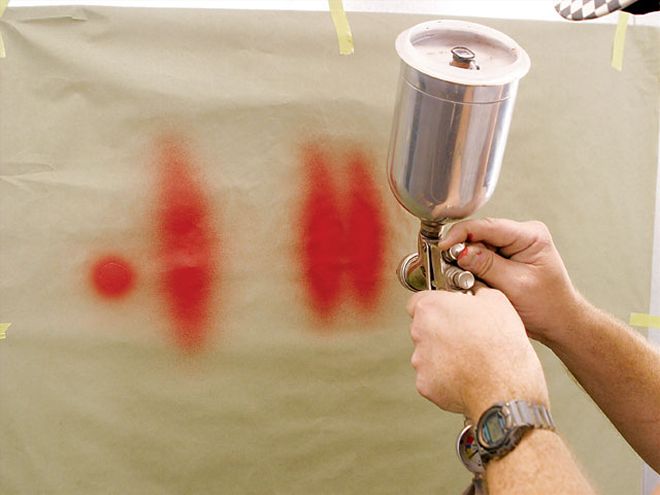 <STRONG>Gun Control</STRONG><BR>At JCP's spray-pattern demo, Morrow shows us how his DeVilbiss gun's fan-control knob can alter the spray pattern. The dot at the far left is with it closed down, the oval next to it is with the valve wide open, and the twin patterns on the right are the "just right" setting he wants.
<STRONG>Gun Control</STRONG><BR>At JCP's spray-pattern demo, Morrow shows us how his DeVilbiss gun's fan-control knob can alter the spray pattern. The dot at the far left is with it closed down, the oval next to it is with the valve wide open, and the twin patterns on the right are the "just right" setting he wants.
Reduced pressure (RP) guns are becoming a popular alternative to HVLP because they offer HVLP-like transfer efficiency but at pressure levels that are just slightly lower than a conventional high-pressure gun, said John Sloane of the Eastwood Co. So if you're used to spraying with a conventional gun, the switch to RP wouldn't be as radical as changing to HVLP. And then there are low volume/low pressure (LVLP) guns. These "make more efficient use of the air supply to them," Sloane said, so they don't require quite as much compressor capacity as an HVLP gun, which makes the whole setup a little more affordable for the hobbyist.
What can you expect to pay for a gun? Eastwood offers "economy" guns for less than $60, while a high-end gun like a German Sata can fetch $700 or more. For that much dough you get "a gun with better feel, a little nicer balance, more careful machining, and probably better durability," Sloane said. "Expensive guns go through more rigorous quality control to ensure more consistent quality for each gun. If you spray day in and day out, I would encourage a higher-end gun. Not only will it feel better in the hand, it will atomize better and transfer efficiencies will be better."
Buy a gun from a supplier that supports the product warranty-wise and can get parts for you if needed, Sloane said. "Usually, if you stick with a known name-DeVilbiss, Binks, Sharpe-you'll be getting a better quality gun than a generic or unlabeled kind of gun." Sloane believes the "ultimate judge of the gun is its ability to apply a smooth finish to the surface. Minimal orange peel is the goal, and effective transfer efficiency is important. The high-pressure guns of 20 years ago wasted as much as three-quarters of the paint that went through them as overspray. HVLP technology dramatically reduced that."
One other tip: Be careful not to over-accessorize a gun. "According to our DeVilbiss rep, the biggest factor that decreases HVLP gun performance is loading it up with accessories-a regulator, moisture filter, restrictive quick disconnects," Sloane said. "Anything you do that restricts the free flow of air to the gun will have a dramatic effect on the gun's performance. A high-pressure gun is more tolerant of these accessories, but with a low-pressure gun, a few psi difference at the inlet will make a big difference in quality."
How To Spray a Car
How to Spray Your Car (cont.)
How To Clean the Spray Gun
Training DaysSeveral paint manufacturers offer classes to keep refinish professionals up-to-date on new products and techniques. But where do you go if you're a dedicated hobbyist looking to brush up on your skills? House of Kolor offers several seminars on how to use its products; one-day orientation and two-day basic classes are open to the public.
We took a basic class at HoK's Dallas training facility and found it to be a screaming deal. You get intensive yet informal (sounds weird, but it works) classroom instruction on a variety of subjects, from paint types and terms to more in-depth topics like how the human eye sees metalflake suspended in paint. Much of the information deals with HoK's products and how they differ from the competition's, but since a HoK custom paint job builds to a higher mil thickness than a collision-repair-based repaint, you need this info to use the HoK products properly.
The two-day class also offers lots of hands-on gun time. In addition to in-booth demonstrations of spraying techniques, students are given a mailbox to refinish in any way they choose. Why a mailbox? Its steel construction has to be scuffed, primered, and finished, just like automotive sheetmetal, and it has curved surfaces to work around, just like a fender. It's smaller and easier to handle than a fullsize car body part, but it's still big enough to accommodate flames, scallops, and other graphics and special effects.
Pass the two-day class and you're eligible to take HoK's four-day advanced course, which is aimed at helping professional shooters expertly use the company's full range of specialty paints. "We'll also spend time duplicating any problems the painters might be having so we can solve them or teach them how to avoid having the trouble in the first place," said Brian Lynch , HoK's training manager.
Best of all, these classes are ridiculously inexpensive. The orientation class is $50, the basic is $100, and the advanced is $500. Those prices include lodging for each day of the class, most meals, all the paint materials, and safety equipment. Yes, HoK is losing money on these things, so sign up now before Lynch comes to his senses and starts charging what they're really worth. Visit www.houseofkolor.com, click on the "News" link, then go to "Training Schedule" for more info.
Tools You'll Need